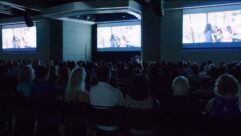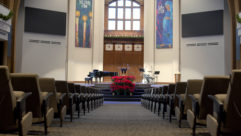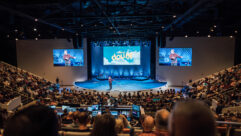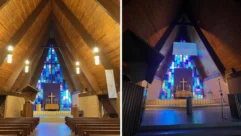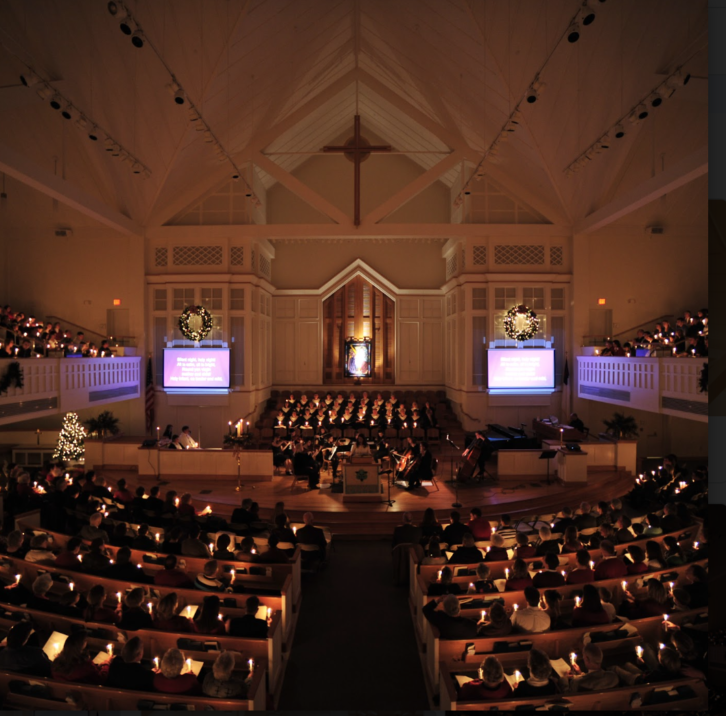
The Vienna Presbyterian Church in Vienna, Virginia faced challenging acoustics and an odd-shaped sanctuary. They also needed a video upgrade so they called in IPS, Integrated Production Solutions in Franklin, Tennessee for the fix. Bryan Levy is here with the story.
Bryan, good to have you with us. This was a pretty interesting project because you had a sort of weird-shaped room to deal with. But before we dive into that, give us an update on IPS.
Bryan Levy: Well, we are growing rapidly, which is super exciting to say. Our production side is continuing to gather clients, and it’s one of these post-Covid things where we’re seeing tours back out and all our A- and B-list artists back on the road. And the same thing in integration. Our salespeople continue to close on great clients and jobs and so my team and I have been out on the road quite a bit. So just happy to be able to keep creating and helping people really get the most out of their facilities and systems.
Today we’re talking about the Vienna Presbyterian Church in Vienna, Virginia near DC. What did they need?
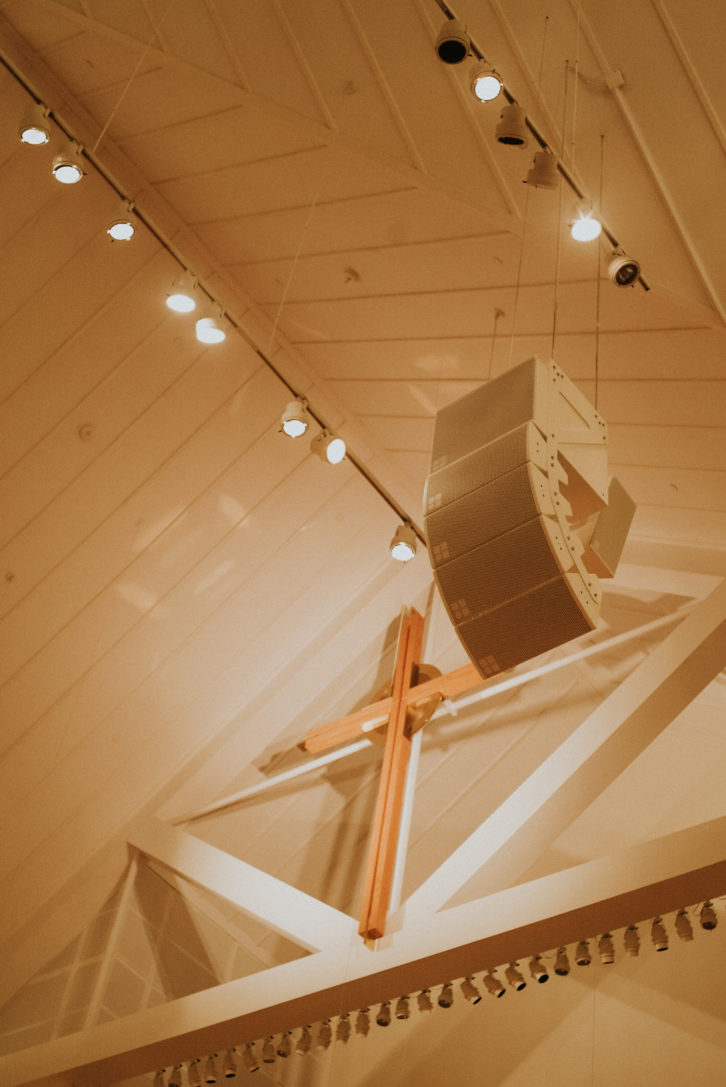 Levy: They had some projectors that were, I’d say, almost older than dirt—they were still in 4:3. But the main thing was the audio was completely dated; it looked like 20 years? It’s a space that’s very focused on aesthetics–everything being clean, technology not being noticeable. Everything they had was surface-mounted or hidden in organ lofts and really wasn’t able to keep up with what they were doing on the music side anymore. So we needed to upgrade them to something that will continue to be aesthetically pleasing but also help with their sonic issues as they’ve grown from a talking head scenario to having full-band worship.
Levy: They had some projectors that were, I’d say, almost older than dirt—they were still in 4:3. But the main thing was the audio was completely dated; it looked like 20 years? It’s a space that’s very focused on aesthetics–everything being clean, technology not being noticeable. Everything they had was surface-mounted or hidden in organ lofts and really wasn’t able to keep up with what they were doing on the music side anymore. So we needed to upgrade them to something that will continue to be aesthetically pleasing but also help with their sonic issues as they’ve grown from a talking head scenario to having full-band worship.
Usually, when a church client wants to upgrade the sound, they’re also very concerned about not disturbing the aesthetics.
Levy: Yes. And this was an all-white building. The ceiling is sheetrock with a fake board and batten. The crazy thing is all the drywall is hung from rod iron behind it. We had to access that drywall to hang this safely and properly. So it required a little bit of thinking and looking at some very, very old blueprints and getting them lined up in the d&b software to see where the best place was for dispersion, what’s going to be the right system for their scenario, and how can we make a tight and clean package in that space so everyone is still happy with the way it looks. But most of all, we wanted to get them this amazing intelligibility and functionality from the system.
The horseshoe shape of the room must have been interesting to deal with. How are the acoustics in that room? Most of the older churches have a pretty high reverb time.
Levy: It did but it didn’t. There is some acoustic treatment in the space on the side walls and on the back walls. The horseshoe shape had all the batten-style finishes on it, so it doesn’t have any acoustic treatment, which kind of stinks. So there was some reverb, but honestly, they were going from a system that had basically no DSB alignment, just boxes shooting everywhere. They had under-balcony speakers that were on two channels, so there was nothing for depth alignment from the front to the back of the building. That was a huge issue because their under-balconies were almost useless as far as vocal intelligibility. We were able to overcome all that. The horseshoe shape is not a new design and it isn’t going away. We’re still seeing new churches being built that way. We’re happy to have the d&b toolbox that really helps us provide a solid and well-rounded system to deal with awkward designs like the horseshoe, or long-depth buildings, or high-ceiling buildings.
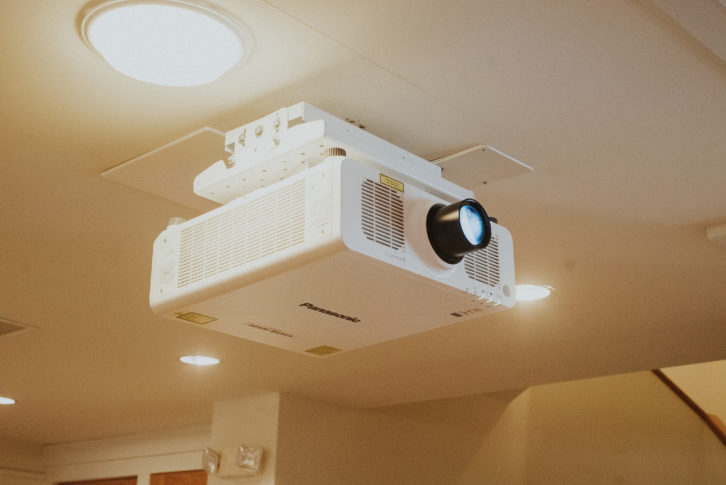 The church has music and singing but the pastor is at the center of things, so how do they mic him?
The church has music and singing but the pastor is at the center of things, so how do they mic him?
Levy: The pastor is on a DPA 4066, I believe, or 4088; one of the two. They’ve had a nice microphone in house, nice wireless. Everything is going through their Yamaha CL5 upstairs. They’ve got Rio racks dispersed throughout the backstage and front of house for playback as well as their band. But the audio out was not well-matched. So it was a major difference to go from a 1980s-90s speaker system. They already have all the front end gear in a good place, but then they were pushing through some really old boxes that weren’t even set up for what they are doing now.
What effect did the position of the previous speakers have on the gain before feedback?
Levy: They had a lot of fun issues with that. Those speakers for the main house were actually behind the front of the stage and were right on the line of the proscenium and the choir loft. They were aimed basically straight down at like a 45- to 60-degree angle towards that main center section of the sanctuary. So that wasn’t fun. It made a huge problem for their choir mics as well. It was a breakthrough to get the PA out 23 feet from where it used to be, but still be able to maintain more than 180 degrees of coverage. It actually kicks back a bit–but being able to avoid the stage so that they can push audio without worrying about rolling low end from kick mics or something, that really just opened up the world to them. It was something that had been plaguing them for a while, especially as they’ve grown as a congregation and as live worship.
You were talking about the d&b software. What steered you to d&b audiotechnik for the sound system solution?
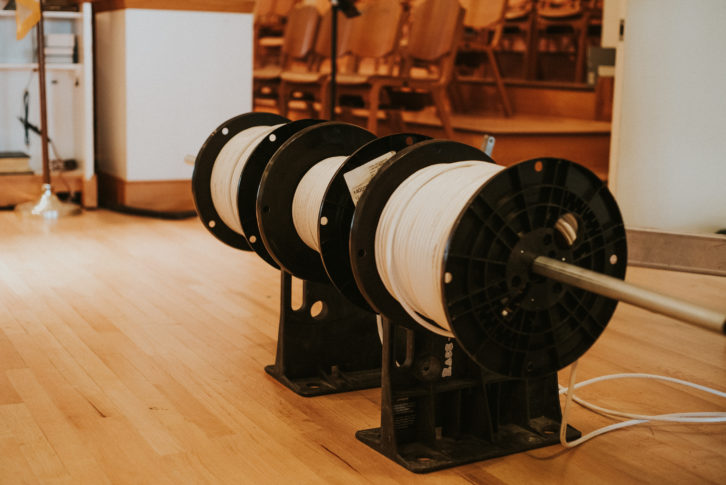 Levy: Well, d&b has an excellent software suite for their array calculation and R1 for their PA programming for their DSP-enabled amplifiers. But honestly, d&b is where we like to go as a general manufacturer. Their quality is fantastic. It’s consistent. They offer great personnel tools. If we need help or have questions we can reach out to their professional services side and customization side; nine times out of ten they turn something around and say ‘this is doable, and we’ll manufacture this just for you.’ This install was no different. The array is an AC series array over a VI sub and the bracket that we fly that on is manufactured there in Germany from, I guess d&b’s sister company—or someone they work with that does custom to d&b specifications. Typically you wouldn’t be able to hang the A-series speakers horizontally underneath that GSUB in such a clean manner. So we went through with ArrayCalc, designed the room, laid it out based on the steel I-beams we were going to access to make sure everything was going to hang safely and look pretty. We worked with d&b to then have them fabricate custom items for us to actually deploy the system. So d&b does an amazing job of supporting us.
Levy: Well, d&b has an excellent software suite for their array calculation and R1 for their PA programming for their DSP-enabled amplifiers. But honestly, d&b is where we like to go as a general manufacturer. Their quality is fantastic. It’s consistent. They offer great personnel tools. If we need help or have questions we can reach out to their professional services side and customization side; nine times out of ten they turn something around and say ‘this is doable, and we’ll manufacture this just for you.’ This install was no different. The array is an AC series array over a VI sub and the bracket that we fly that on is manufactured there in Germany from, I guess d&b’s sister company—or someone they work with that does custom to d&b specifications. Typically you wouldn’t be able to hang the A-series speakers horizontally underneath that GSUB in such a clean manner. So we went through with ArrayCalc, designed the room, laid it out based on the steel I-beams we were going to access to make sure everything was going to hang safely and look pretty. We worked with d&b to then have them fabricate custom items for us to actually deploy the system. So d&b does an amazing job of supporting us.
Tell us about the customized rigging and color finish.
Levy: Everything was white. And in a world where PAs don’t typically come in white, you know that’s a big deal. To then have the rigging be white was crazy–we have powder-coated white rigging. We even ended up painting the heads of all the bolts to be white as well; all the aircraft cables are white, all the speaker cables we got in white. So at a quick glance, even though it’s hung from quarter-inch aircraft cable, you walk in and it really is like the PA just kind of floats in the space surrounded by white in the foreground and the background. It’s almost artistic, how well it disappeared into the room, which is what the client wanted. They wanted superior sound, superior clarity with minimal aesthetic challenges, and they wanted to be able to see their cross that they have hung as the focal point. They were really blown away with what they were able to achieve sonically but also visually.
I saw that there was some cutting and sawing through the drywall so it appears the conduit was a challenge. How much time did your guys have on this?
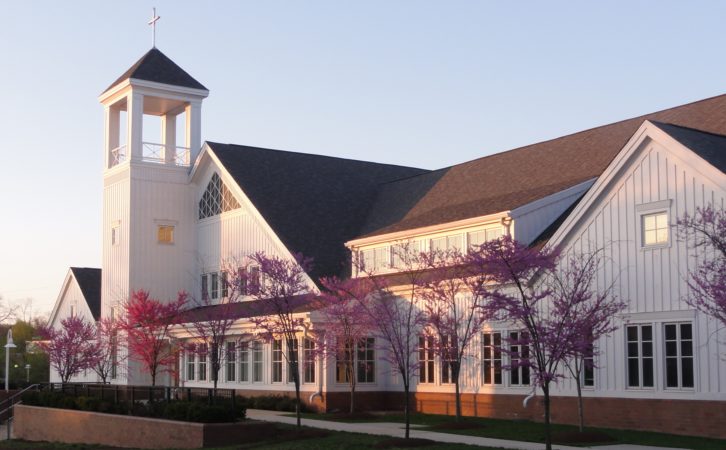 Levy: We were in and out with audio, video, everything in five days. The main thing is we get there on a Sunday night. First thing Monday morning all our pallets arrive, we get at it, and by Friday we gotta have stuff done because they have to reset, do sound checks on Saturday to be ready for a Sunday service. Fortunately, the church was large enough to utilize a different space for their Wednesday night and worship rehearsal, but it had to be quick. So we ran and bent conduit ourselves to match the hardscape of the ceiling so it would be less visually impairing, and everything got painted white. Then we were able to run all the actual wires once we got behind the facades of the choir loft and the speaker loft for the organ. Everything was discrete and just disappeared into the foreground. You just can’t even tell.
Levy: We were in and out with audio, video, everything in five days. The main thing is we get there on a Sunday night. First thing Monday morning all our pallets arrive, we get at it, and by Friday we gotta have stuff done because they have to reset, do sound checks on Saturday to be ready for a Sunday service. Fortunately, the church was large enough to utilize a different space for their Wednesday night and worship rehearsal, but it had to be quick. So we ran and bent conduit ourselves to match the hardscape of the ceiling so it would be less visually impairing, and everything got painted white. Then we were able to run all the actual wires once we got behind the facades of the choir loft and the speaker loft for the organ. Everything was discrete and just disappeared into the foreground. You just can’t even tell.
What are you using to power this sound system and where did you locate the amps?
Levy: They are upstage left. It’s three 40D d&b amplifiers and two 10Ds. They’re all networked together so if the users have to go and make adjustments or alignment changes or tweaks or EQ or volume adjustments inside the DSP they can grab all five amplifiers from one location without having to move Ethernet cables or anything.
And then you used the 44S point source speakers to fill that space under the balcony?
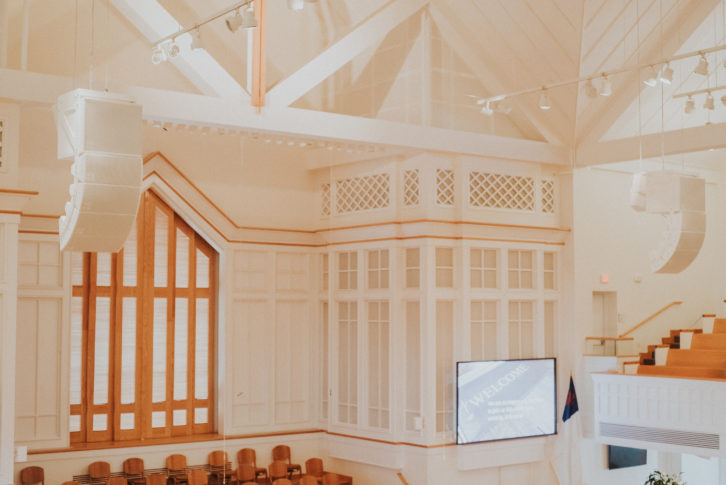 Levy: That’s correct. They’re super slim and incredibly powerful for as small of a format that they are. To create the arched under-balc ring there are three on either side, two in the back. But they are wired in pairs laterally from each other, so as we get further back from the stage we align them in singular pairs all the way to underneath the front of house on the under-balcony there. Like I said before there was a timing in there so that as everyone is moving around or getting to their seats, there is no acoustic cancellation or echo or comb filtering between the speakers.
Levy: That’s correct. They’re super slim and incredibly powerful for as small of a format that they are. To create the arched under-balc ring there are three on either side, two in the back. But they are wired in pairs laterally from each other, so as we get further back from the stage we align them in singular pairs all the way to underneath the front of house on the under-balcony there. Like I said before there was a timing in there so that as everyone is moving around or getting to their seats, there is no acoustic cancellation or echo or comb filtering between the speakers.
You mentioned that it’s the Yamaha mixer they use for control. That’s great for training the newbies on the production crew.
Levy: Yes. It takes the fun of the old-school M7 and it takes a little bit of the PM life of the five Ds and puts it together. Super easy to use console, very quick and intuitive. Dante-controlled for all the under-stage boxes, so they didn’t have to run a ton of copper. So yeah, a great console for churches and even for production. Just quick and easy.
How did you set up the video aspect of this project?
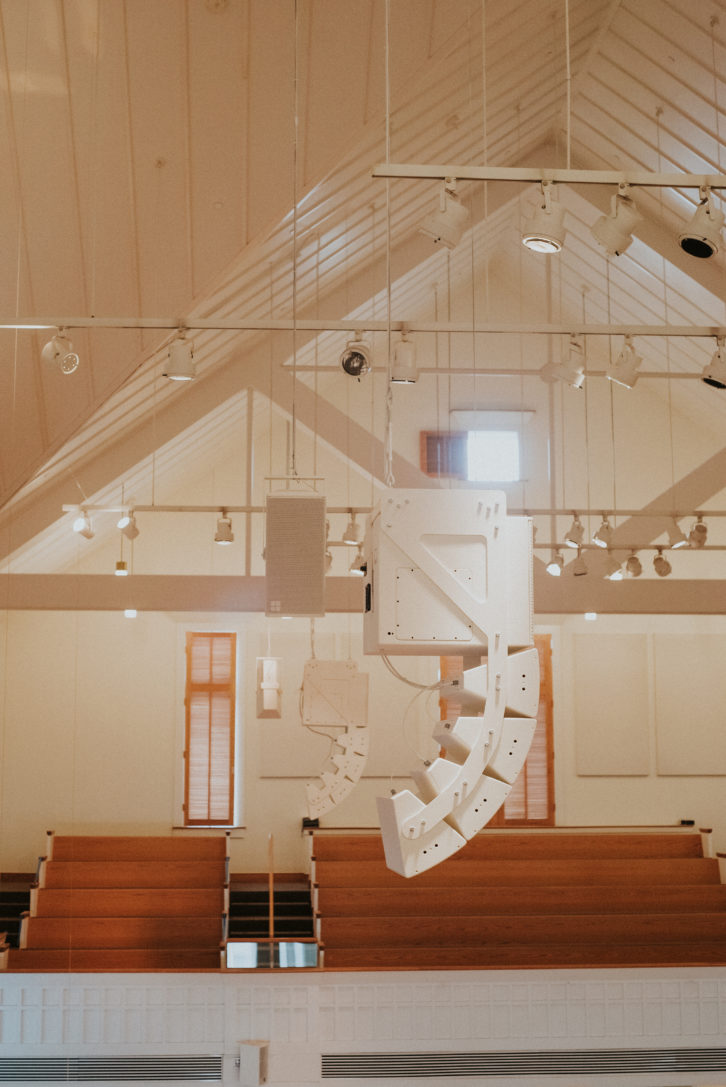 Levy: Honestly, that was the easier part of it. Ironically though, we still had to get into the drywall where the previous installer had not hung things, shall we say, to spec. We made sure to get beam clamps to the under rod steel of the under-balcony to drop down to proper inch and a half threaded pipe. You can hang a horse off the bottom of the pipe mount now and it won’t jiggle, where previously they were having issues with vibration. It’s a long-throw lens projector shooting about 80 feet from underneath the balcony all the way to the stage there in front of the organ loft. We went with acoustical screen fabric in a 16:9 where they were 4:3 before. The issue was not to diminish the organ sound, so we went with an acoustical fabric very similar to what you see in a movie theater.
Levy: Honestly, that was the easier part of it. Ironically though, we still had to get into the drywall where the previous installer had not hung things, shall we say, to spec. We made sure to get beam clamps to the under rod steel of the under-balcony to drop down to proper inch and a half threaded pipe. You can hang a horse off the bottom of the pipe mount now and it won’t jiggle, where previously they were having issues with vibration. It’s a long-throw lens projector shooting about 80 feet from underneath the balcony all the way to the stage there in front of the organ loft. We went with acoustical screen fabric in a 16:9 where they were 4:3 before. The issue was not to diminish the organ sound, so we went with an acoustical fabric very similar to what you see in a movie theater.
And you went with Panasonic on the projectors.
Levy: Yes. We went laser phosphor. Panasonic laser phosphor projectors are fantastic and have lots of lens options to make sure, especially in this scenario where we’re shooting from underneath the balcony clear across the room, that we get the maximum lumen output all the way to the screen. And this church is no stranger to windows; we can still cut through during that 10am service with all the sunlight coming in.
I’m sure they were glad to get in there and start playing with it as soon as it was ready to go.
Levy: Oh, they were wanting to play while we were still doing it. So I can’t blame them. I think they finally got to a point where they rounded out all aspects of their facility where they have done slow upgrades to their infrastructure, their wireless and console. And getting a proper sound system in there and getting and updated projection system, I think, puts them in a great place for many years to come.
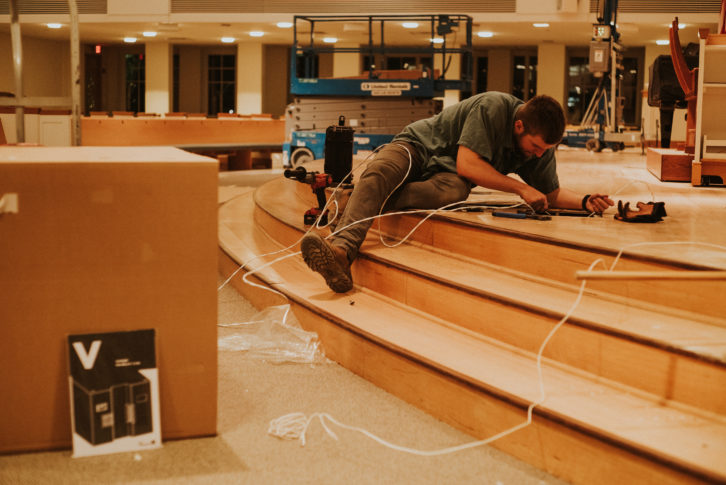 So what does IPS have coming up next?
So what does IPS have coming up next?
Levy: We still have houses of worship all the time. I’m in Chattanooga coming up trying to finish up a church there. We’ll be in Ohio for a large job that’s also doing IMAG screens and main LED walls as well as a large church south of Nashville here, their satellite campus is becoming a main campus. We’re doing a cable cam installation, which is really cool–something you think as off the wall for sports, but even more off the wall for a worship scenario. So super progressive, contemporary worship and really unique ways to stretch the limits there.
Getting back to busy again.
Levy: Yes, sir.


